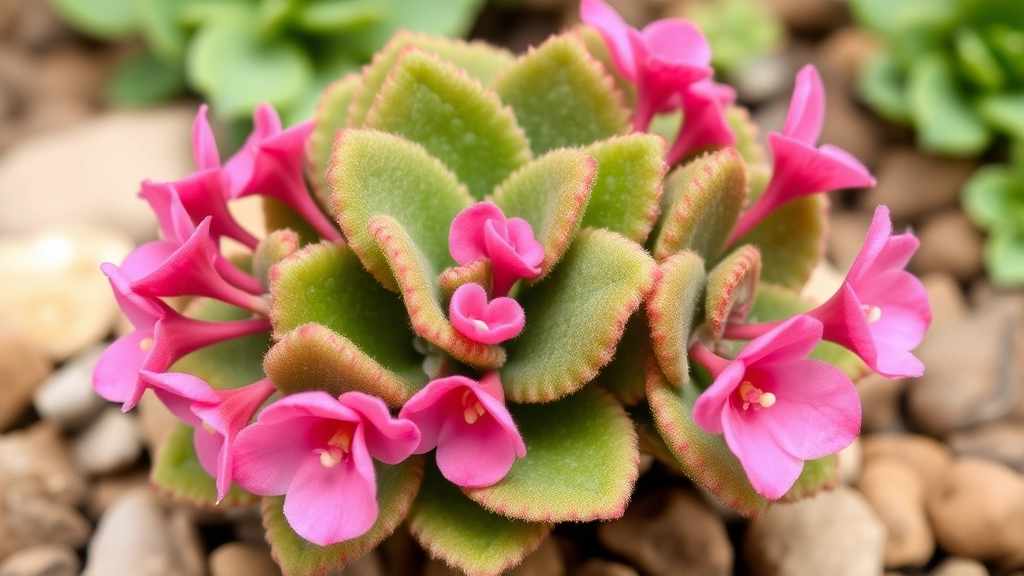Welcome, plant enthusiasts!
Today, we’re diving into the fascinating world of Kalanchoe beharensis, affectionately known as the felt plant. This unique succulent, with its velvety leaves and striking appearance, is about to become your new green obsession. From its low-maintenance care to its eye-catching presence, we’ll explore why this Madagascar native is a must-have for both novice gardeners and seasoned plant collectors alike.
In this comprehensive guide, we’ll cover everything from ideal growing conditions and propagation techniques to common pests and decorative uses. Whether you’re looking to add some texture to your indoor jungle or create a drought-resistant outdoor oasis, the Kalanchoe beharensis has got you covered. So, let’s embark on this fuzzy adventure and discover why the felt plant is stealing hearts in the succulent world!
Overview of Kalanchoe Beharensis
Let’s chat about Kalanchoe Beharensis, aka the Felt Plant.
Ever seen a plant that looks like it’s wearing a fuzzy coat?
That’s our guy, the Kalanchoe Beharensis.
It’s a real head-turner in the succulent world.
Originally from Madagascar, this plant’s got some serious character.
It’s like the cool, quirky cousin in the succulent family.
Think big, velvety leaves that feel like felt (hence the nickname).
These leaves can grow up to 20 inches long. No joke.
The plant itself? It can reach up to 10 feet tall in the wild.
But don’t worry, it’s usually more manageable in pots.
Kalanchoe Beharensis is part of the Crassulaceae family.
It’s a tough cookie, drought-resistant and low-maintenance.
Perfect for those of us who aren’t exactly plant whisperers.
The Felt Plant’s not just a pretty face, though.
It’s got some cool features that make it stand out:
- Triangular, silvery-green leaves
- A fuzzy texture that’s irresistible to touch
- Bronze-coloured leaf undersides
- Tiny, bell-shaped flowers (but they’re rare in cultivation)
Bottom line: Kalanchoe Beharensis is a unique, eye-catching plant that’s surprisingly easy to care for.
Whether you’re a seasoned plant parent or a newbie, this fuzzy friend is worth considering.
Distinctive Features of the Felt Plant
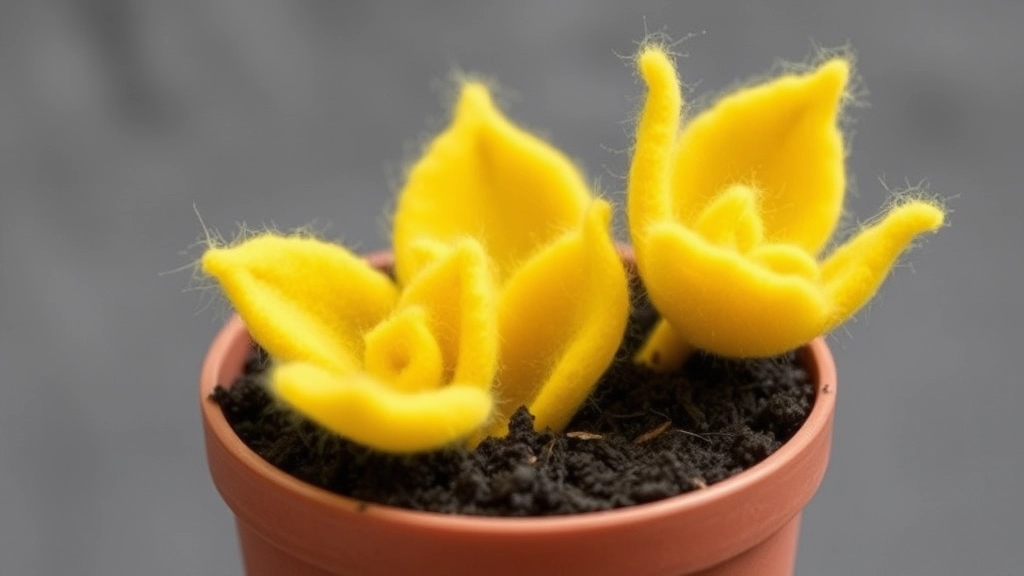
Let’s dive into what makes the Kalanchoe Beharensis, or Felt Plant, stand out from the crowd. Trust me, this isn’t your average houseplant!
The Fuzzy Factor
First things first, the Felt Plant’s leaves are its claim to fame. They’re not just green; they’re covered in a thick, velvety fuzz that feels like, well, felt! This unique texture isn’t just for show – it’s the plant’s clever way of conserving water in its native Madagascar.
Size Matters
Now, don’t be fooled by its cute nickname. This bad boy can grow up to 3-4 meters tall in the wild! In your home, it’ll likely stay more manageable, but still expect a hefty plant that’ll make a statement.
Leaf Shape and Colour
The leaves aren’t just fuzzy; they’re massive! We’re talking triangular beauties that can reach up to 20 inches long. And the colour? A silvery-green that’ll add some serious pop to your plant collection.
Quirky Edges
Here’s a fun fact: the leaf edges are wavy and sometimes have little plantlets growing along them. It’s like the plant’s trying to clone itself right before your eyes!
Flowers (But Don’t Hold Your Breath)
While the Felt Plant can flower, it’s pretty rare indoors. If you’re lucky, you might see some small, yellowish-green blooms. But let’s be real – we’re here for those fuzzy leaves!
Slow and Steady Growth
This isn’t a plant for the impatient. It grows slowly, which is great if you’re not looking to repot every five minutes. Plus, it means you can enjoy its current size for longer.
So, there you have it – the Kalanchoe Beharensis in all its fuzzy glory. It’s a plant that’s sure to turn heads and spark conversations. Just try not to pet it too much! If you’re interested in other unique Kalanchoe varieties, you might want to check out the Kalanchoe tomentosa ‘Chocolate’ for its striking dark leaves.
Ideal Growing Conditions
Alright, let’s dive into the ideal growing conditions for Kalanchoe Beharensis.
Here’s the deal with these funky felt plants:
- They’re tough cookies, but they’ve got their preferences.
- First off, they love warmth. Think tropical vibes.
- Ideal temperature? Around 60-75°F (15-24°C).
- But here’s the kicker – they can handle a bit of cold too.
- Just don’t let it drop below 50°F (10°C) for too long.
Now, humidity’s not a big deal for these guys.
They’re pretty chill about it, but they don’t mind a bit of moisture in the air.
Here’s a pro tip: if you’re growing them indoors, a pebble tray can work wonders.
Light’s crucial. These fellas love it bright.
But direct sunlight? Not so much. It can scorch their leaves.
Think bright, indirect light. That’s the sweet spot.
Got a south-facing window? Perfect. Just pop a sheer curtain up.
Outdoors, they’re happiest in partial shade.
Remember, these plants are succulents at heart.
They’re built for dry conditions, so don’t go overboard with the pampering.
Well-draining soil is a must. We’ll get into that in the next section.
Bottom line: Kalanchoe Beharensis is pretty adaptable.
Get these basics right, and you’re golden.
Soil and Potting Requirements
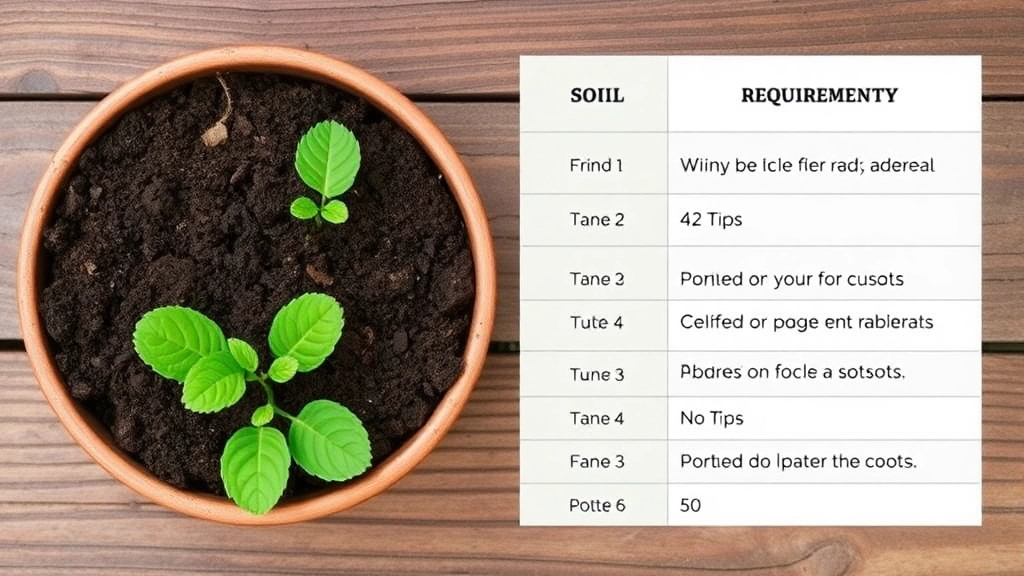
Alright, let’s dive into the soil and potting requirements for our Kalanchoe beharensis, or as I like to call it, the felt plant. Trust me, getting this right is crucial for your plant’s happiness.
Here’s the deal with Kalanchoe beharensis – it’s not fussy, but it does have some preferences. Let’s break it down:
Soil Mix:
- Think well-draining and slightly acidic
- Aim for a pH between 6.0 and 7.5
- Mix equal parts potting soil, perlite, and coarse sand
Why this mix? It’s all about mimicking the plant’s natural habitat. The felt plant hates wet feet, so drainage is key.
Potting Tips:
- Choose a pot with drainage holes – non-negotiable
- Go for terracotta or unglazed ceramic pots – they help wick away excess moisture
- Size matters – pick a pot that’s about 2 inches larger than the root ball
Here’s a pro tip: Add a layer of gravel at the bottom of the pot. It’s like giving your plant a pair of wellies to keep its feet dry.
Repotting:
- Do it every 2-3 years, or when you see roots peeking out of the drainage holes
- Best time? Early spring, just as the growing season kicks off
Remember, Kalanchoe beharensis isn’t a fan of being root-bound. It’s like wearing shoes that are too tight – uncomfortable and stunts growth.
Soil Amendments:
- Toss in some slow-release fertilizer when potting
- A handful of crushed eggshells can boost calcium levels
Bottom line: The right soil and pot setup is like giving your felt plant a cozy home. Get this right, and you’re setting the stage for a thriving, happy plant. Trust me, your Kalanchoe beharensis will thank you with gorgeous, velvety leaves and impressive growth. If you’re interested in other Kalanchoe varieties, you might want to check out the Kalanchoe tomentosa propagation guide for more succulent care tips.
Watering and Feeding Guidelines
Hey, let’s chat about keeping your Kalanchoe beharensis happy and thriving.
Water? Less is more with these succulents.
They’re drought-tolerant champs, so don’t go overboard.
Here’s the deal:
- Water deeply, but only when the soil’s bone dry
- In summer, that might be every 1-2 weeks
- Winter? Even less – maybe once a month
Overwatering’s a killer, so err on the dry side.
Now, food:
- Feed during growing season (spring and summer)
- Use a balanced, water-soluble fertiliser
- Dilute it to half strength – these guys aren’t big eaters
- Once a month is plenty
Pro tip: Skip fertilising in autumn and winter when growth slows.
Remember, Kalanchoe beharensis is tough. It’s better to underwater than overdo it.
Got questions about your plant’s specific needs? Drop ’em in the comments!
Light and Temperature Needs
Alright, let’s chat about what the Kalanchoe Beharensis needs to thrive when it comes to light and temp. Trust me, getting this right can make or break your plant game.
Light: The Bright Side of Life
These fellas are sun worshippers, no doubt about it. Here’s the deal:
- Full sun to partial shade is their sweet spot
- Aim for at least 6 hours of direct sunlight daily
- Morning sun is best, especially in hotter climates
But hey, don’t go scorching your plant! If you’re in a place where the sun’s like a blowtorch, give it some afternoon shade. Nobody likes a sunburnt succulent, right?
Temperature: Keeping It Cozy
Now, about temp – these guys aren’t too fussy, but they’ve got their limits:
- Ideal range: 60°F to 85°F (15°C to 29°C)
- Can handle brief dips to 40°F (4°C)
- Not frost-hardy – keep ’em inside if it’s freezing out
Pro tip: If you’re growing these indoors, keep ’em away from cold drafts or AC vents. They’re not fans of sudden temp changes.
Indoor vs. Outdoor: The Great Debate
Wondering if you should keep your Kalanchoe Beharensis inside or out? Here’s my take:
- Outdoors: Great in warm climates (USDA zones 9-11)
- Indoors: Perfect near a sunny window
- Balcony or patio: Ideal spot for that indoor-outdoor vibe
Remember, these plants are pretty adaptable. Just keep an eye on them and they’ll let you know if they’re happy or not.
Bottom line: Kalanchoe Beharensis loves its light bright and its temps warm. Get these right, and you’ll have a thriving, eye-catching plant that’ll make your space pop. Now go forth and grow, my friend! If you’re interested in other varieties, check out the Kalanchoe Blossfeldiana, which is another popular species.
Common Pests and Diseases
Let’s talk about the nasty critters and issues that might bug your Kalanchoe beharensis.
Trust me, I’ve seen my fair share of plant problems, and this felt plant isn’t immune.
Mealybugs
These little cotton-ball lookalikes love to party on your plant.
Spot ’em early, and you’re golden. A quick wipe with rubbing alcohol usually does the trick.
Scale insects
Tiny vampires that suck the life out of your plant.
I once battled these on my Kalanchoe. Neem oil became my best friend.
Root rot
Overwatering is the culprit here.
Been there, done that. Now I always check the soil before watering.
Fungal leaf spots
Humidity’s the enemy here.
Pro tip: Improve air circulation around your plant.
Powdery mildew
Another moisture-loving menace.
I keep my Kalanchoe in a well-ventilated spot to avoid this headache.
Remember, prevention’s better than cure.
Keep your plant healthy, and it’ll fight off most issues on its own.
Regular checks and quick action are your best defense against pests and diseases.
Trust me, your Kalanchoe beharensis will thank you for the TLC.
Propagation Techniques
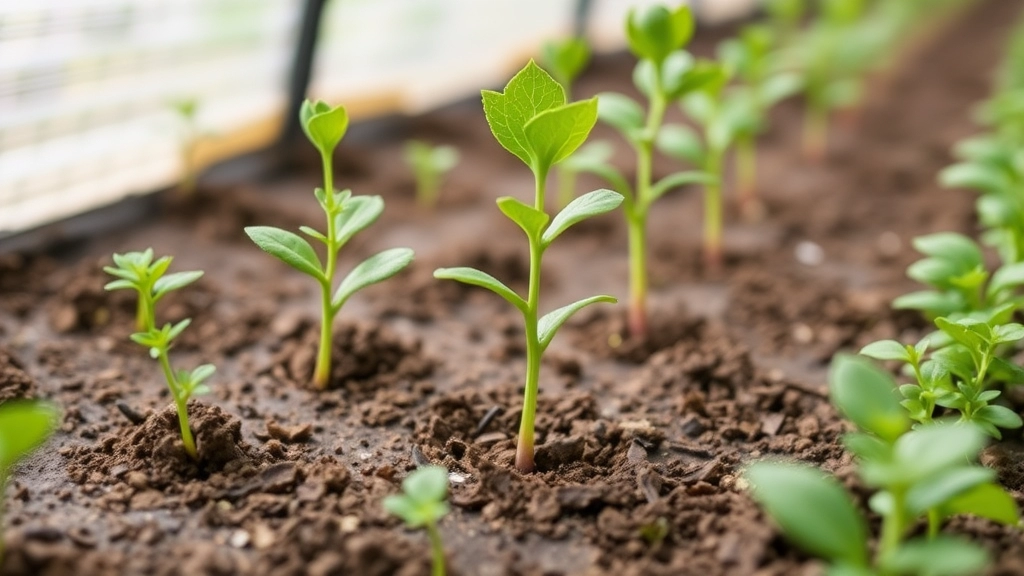
Listen up, folks! Let’s talk about how to make more of these awesome Kalanchoe Beharensis plants. It’s not rocket science, but there are a few tricks to get it right.
Stem Cuttings: The Go-To Method
Here’s the deal with stem cuttings:
- Snip a healthy stem, about 4-6 inches long
- Let it dry for a day or two (trust me on this)
- Stick it in some well-draining soil
- Keep it warm and slightly moist
Boom! In a few weeks, you’ll see roots. It’s like magic, but it’s just plant biology doing its thing.
Leaf Cuttings: The Backup Plan
Not feeling the stem cutting vibe? No worries. Try leaf cuttings:
- Pluck a mature leaf
- Let the cut end callous over (patience, my friend)
- Lay it on top of soil or stick the end in
- Mist occasionally
It’s slower than stem cuttings, but hey, good things come to those who wait.
Seeds: For the Patient Gardener
Alright, this one’s for the long game players:
- Sow seeds in spring
- Use a seed starting mix
- Keep warm and moist
- Wait… and wait some more
It takes time, but there’s something satisfying about growing from seed, right?
Pro Tips:
- Use rooting hormone for better success (it’s like a power-up for your cuttings)
- Keep propagations out of direct sun at first (they’re babies, be gentle)
- Be patient – these aren’t fast-growing plants
Remember, propagating Kalanchoe Beharensis is all about giving it the right conditions and letting nature do its thing. It’s not hard, but it does require a bit of know-how and patience. Give it a shot, and before you know it, you’ll have a whole army of elephant ear Kalanchoe!
Pruning and Maintenance Tips
Let’s chat about keeping your Kalanchoe beharensis looking its best.
Pruning this bad boy isn’t rocket science, but it’s key for a healthy plant.
Here’s the deal:
- Snip off any dead or yellowing leaves as soon as you spot ’em.
- Trim back leggy stems to encourage bushier growth.
- Don’t go crazy – just a light trim now and then does the trick.
Maintenance? It’s pretty chill:
- Dust those fuzzy leaves occasionally – they’re like little dust magnets.
- Rotate the pot every few weeks for even growth.
- Check for pests regularly – prevention’s better than cure, right?
Pro tip: Use clean, sharp tools when pruning to avoid spreading diseases.
Remember, less is more with these guys. They’re tough cookies and don’t need much fussing over.
Got any weird growth or funky spots? Don’t panic – just snip ’em off.
Keeping your Kalanchoe beharensis in check is easy peasy with these simple tips.
Benefits of Growing Kalanchoe Beharensis
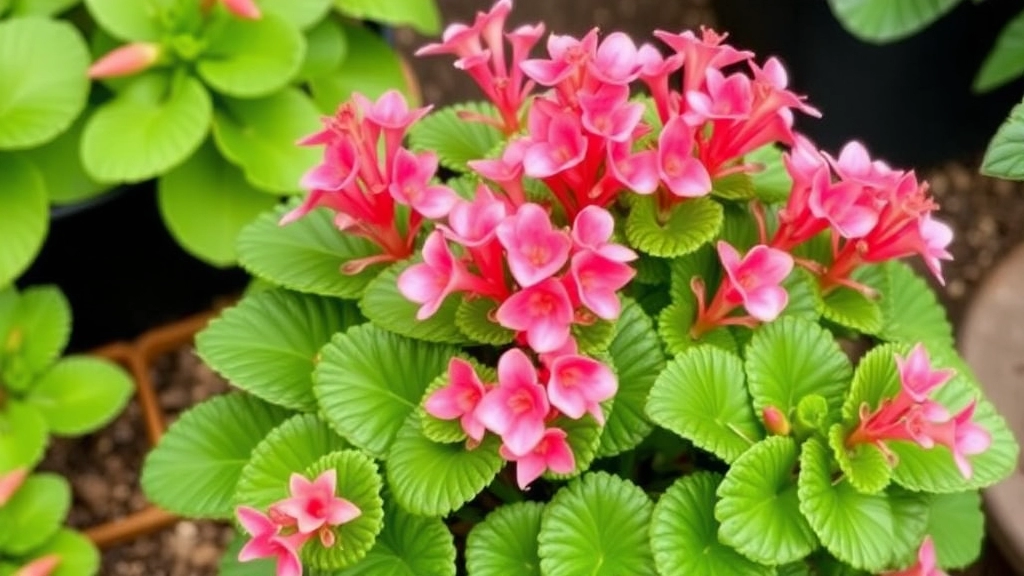
Let’s chat about why you might want to add a Kalanchoe Beharensis, or Felt Plant, to your green squad. Trust me, this isn’t just another pretty face in the plant world.
First off, these bad boys are tough as nails. I’m talking survive-a-zombie-apocalypse tough. They’re perfect for folks who can’t seem to keep a cactus alive (no judgement, we’ve all been there).
Here’s why I’m all about the Felt Plant:
- Low maintenance: It’s like the plant version of a low-key friend. Doesn’t need much, but always looks good.
- Drought-resistant: Forgot to water it for a week? No biggie. This plant’s got your back.
- Air purifier: It’s basically a natural air freshener, minus the fake scents.
- Unique look: Those fuzzy leaves are a conversation starter. Trust me, your mates will be asking about it.
But wait, there’s more:
- Pest resistant: Bugs usually give it a hard pass. Less creepy crawlies = happy plant parent.
- Long-lived: With proper care, these plants can stick around for years. It’s like adopting a green pet.
- Propagation potential: Easy to multiply. Share the love with your plant-obsessed friends.
Now, I’m not saying it’s a miracle worker, but having a Kalanchoe Beharensis around can:
- Boost your mood (green stuff tends to do that)
- Add a touch of the exotic to your space
- Make you feel like a proper plant pro
Bottom line? The Kalanchoe Beharensis is a win-win. It’s easy to grow, looks cool, and has some sweet perks. Whether you’re a newbie or a green thumb guru, this plant’s got something for everyone. So why not give the Felt Plant a shot? Your indoor jungle (and your sanity) will thank you.
Decorative Uses in Landscaping and Interiors
Let’s chat about how to make your space pop with Kalanchoe beharensis. This bad boy isn’t just a plant; it’s a statement piece.
Indoor Wow Factor
- Focal point: Stick this beast in a corner, and watch it steal the show.
- Texture play: Those fuzzy leaves? They’re begging to be touched.
- Size matters: Got high ceilings? This plant’s your new best friend.
Outdoor Drama
- Xeriscaping hero: Drought-tolerant and eye-catching? Double win.
- Contrast king: Plant it next to smooth-leaved plants for a texture party.
- Container champion: Perfect for patios or balconies where you want some oomph.
Styling Tips
- Go big or go home: Large pots = dramatic impact.
- Mix it up: Pair with succulents for a desert vibe.
- Light it right: Uplighting at night makes those leaves look otherworldly.
Real talk: I once stuck a Kalanchoe beharensis in my office lobby. Clients couldn’t stop talking about it. It was like having a living sculpture that didn’t need constant babysitting.
Remember, this plant’s not just about looks. It’s low-maintenance, which means more time enjoying, less time fussing. Whether you’re jazzing up your living room or creating an outdoor oasis, Kalanchoe beharensis is your secret weapon for instant impact.
So, ready to make your space stand out? Grab a Kalanchoe beharensis and let the compliments roll in. Trust me, it’s a game-changer in the world of decorative plants.
FAQs about Kalanchoe Beharensis (Felt Plant)
Q: How often should I water my Kalanchoe Beharensis?
A: Water your Felt Plant only when the soil is completely dry. In summer, this might be every 1-2 weeks, while in winter, it could be as infrequent as once a month. Remember, it’s better to underwater than overwater these drought-tolerant succulents.
Q: Can I grow Kalanchoe Beharensis outdoors?
A: Yes, you can grow Kalanchoe Beharensis outdoors in USDA zones 9-11. They thrive in warm climates with partial shade. If you live in a colder region, you can keep them in containers and bring them indoors during winter.
Q: How big does a Kalanchoe Beharensis get?
A: In its natural habitat, Kalanchoe Beharensis can grow up to 10 feet tall. However, when grown in pots or indoors, it typically reaches a more manageable height of 3-4 feet.
Q: Is Kalanchoe Beharensis toxic to pets?
A: While not highly toxic, Kalanchoe species can cause mild gastrointestinal upset if ingested by pets. It’s best to keep the plant out of reach of curious pets and children.
Q: How do I propagate my Felt Plant?
A: The easiest way to propagate Kalanchoe Beharensis is through stem cuttings. Take a 4-6 inch cutting, let it dry for a couple of days, then plant it in well-draining soil. Leaf cuttings can also work, but they take longer to root.
Q: Why are the leaves on my Kalanchoe Beharensis turning yellow?
A: Yellowing leaves often indicate overwatering. Ensure your plant has well-draining soil and only water when the soil is completely dry. If the problem persists, check for root rot and adjust your watering schedule.
Q: Does the Felt Plant flower?
A: While Kalanchoe Beharensis can produce small, bell-shaped flowers in its natural habitat, it rarely flowers when grown as a houseplant. The plant is primarily grown for its unique, fuzzy foliage.
Q: How often should I fertilize my Kalanchoe Beharensis?
A: Fertilize your Felt Plant once a month during the growing season (spring and summer) with a balanced, water-soluble fertilizer diluted to half strength. Avoid fertilizing in autumn and winter when growth slows down.
References
-
Missouri Botanical Garden – Kalanchoe beharensis Plant Finder: Kalanchoe beharensis
-
University of Florida IFAS Extension – Kalanchoe beharensis Kalanchoe beharensis Felt Plant, Velvet Leaf

